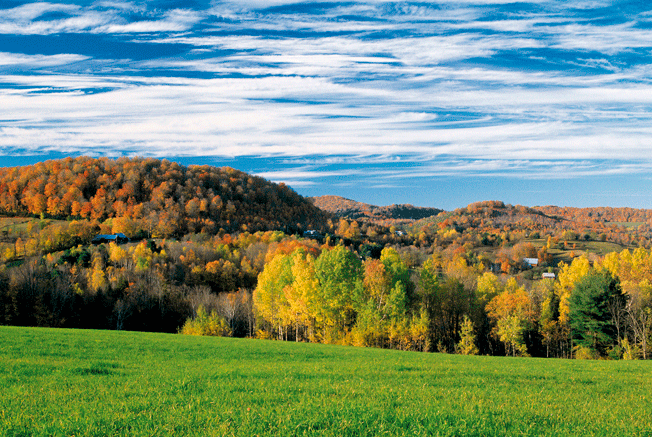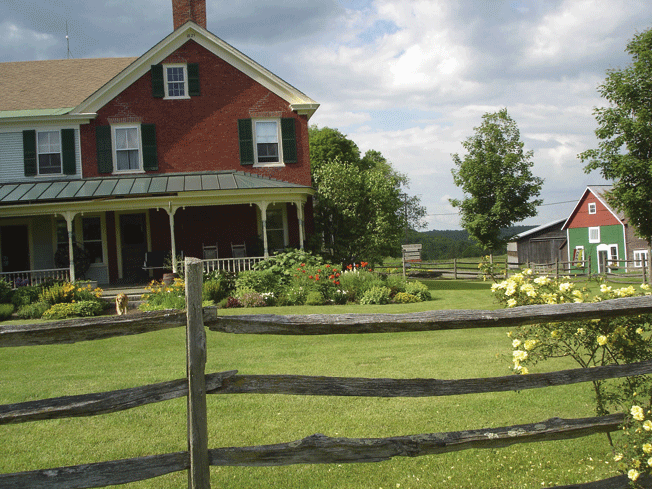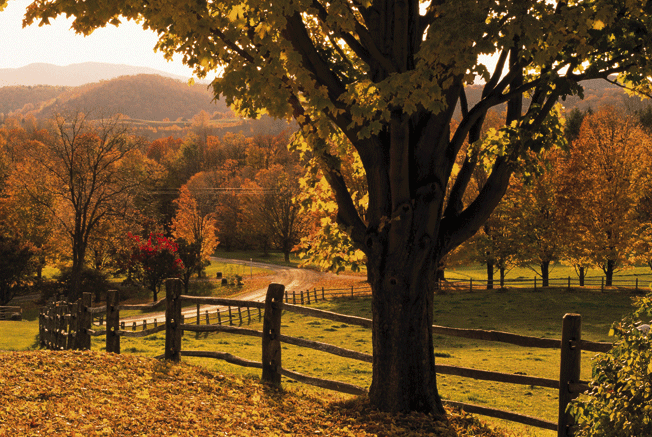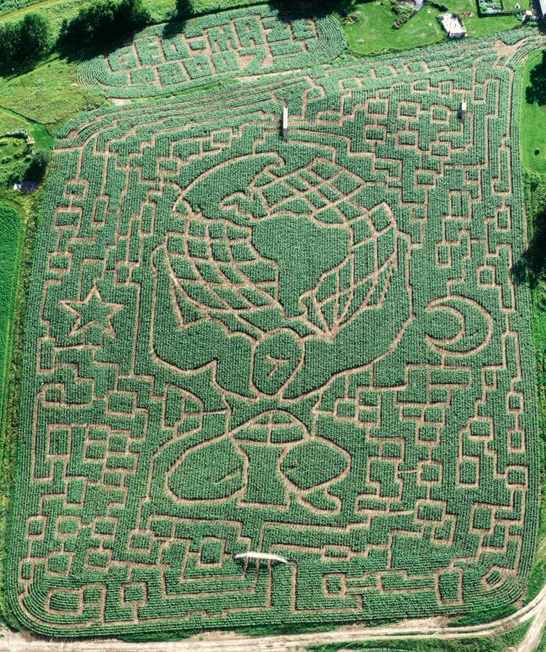
Travel
 Vermont
Vermont
Back to the Land on a Farm Vacation
Watching my children explore the barn, interacting with the animals and answering their endless questions made it one of the best family vacations we've ever had.
By: Neil Dunlop
It was dark outside, but I could see the warm yellow glow of lights in the barn. I nudged my wife and we woke our three young children with whispers, dressed them and, with the moon still in the sky, trod silently across the frosty lawn to the barn doors.
Once inside, we were met with a cacophony of clucks, moos, squawks and meows. As we stood there blinking in the bright light and taking in all the sights and smells of the barn, farmer Bob Light and his wife, Lee, moved efficiently, tending to their animals. They soon gave us buckets, bottles and shovels and put us to work feeding the chickens, turkeys and ducks while our twin two-and-a-half-year-old daughters chased kittens and cuddled them with the tender intensity of new mothers. Catherine was given a huge bottle of milk to feed the year-old Jersey calf. The calf's suction was so strong she had trouble holding on to the bottle.
You don't have to pitch in if you stay at Hollister Hill Farm in north-central Vermont, but for us it was part of the experience. You also don't have to wake before dawn, but that was part of it, too. We could visit the barn anytime during our three days at the farm, but we loved feeding time in the morning, when the animals were most lively. Helping out also made us feel like we earned the huge farmhouse breakfast that the Lights served on their runway-length table. If you've helped collect the eggs, you would appreciate the food all the more. 
After breakfast we usually stopped on the porch to pet the resident golden retrievers, Cinnamon and Ruby, docile and handsome dogs that the Lights breed to sell puppies. It's just one of the many businesses they run in order to keep the farm going. In 1972 the Lights moved to Vermont from New Jersey as part of the back-to-the-land movement. They've seen a lot of changes in farming in the past 36 years, and none have made their lives any easier. So, to make ends meet, in addition to running their bed and breakfast, they breed dogs, make maple syrup, grow and sell hay, and raise turkeys for Thanksgiving, beefalo (a bison/domestic cattle mix) and poultry for meat and fresh eggs, which they sell from a small store in the barn.
Around 52,000 U.S. farms are involved in some form of tourism, from farm stays to petting zoos, according to a 2004 United States Department of Agriculture survey. It's big in Europe and is gaining in popularity here. Jane Eckert, a Missouri-based agritourism marketing consultant, says that she has noticed a marked increase in the number of U.S. farmers interested in tourism in the past 15 years. “I know of many farms,” she says, “that earn more than half their income from agritourism.”
Still, farming is hard work. The Lights' chores start at dawn and end after sunset. The animals need care every single day of the year. Add to that the time put in to maintain the farm, property and machines, and it's amazing that the Lights and other farmers find the energy to keep going. Though my children were a bit young to appreciate the Lights' commitment, they did learn the origins of the food we eat. When they collected eggs, even receiving a peck for their trouble, they understood that these were the same eggs they eat at breakfast. Watching them explore the barn, interacting with the animals and answering their endless questions made it one of the best family vacations we've ever had. Of course, not every visitor is quite so adventurous. One day we watched a German physician, another guest, emerge from the barn, examine her shoes and immediately rub disinfectant on her hands. 
Even if you don't want to interact with the livestock, Hollister Hill is a beautiful place to visit. We strolled through the pastures to look for the beefalo herd, tossed fallen apples in the old orchard, visited the large herb and vegetable garden, examined the tractors and other machines and played in the hayloft.
There are also plenty of activities in the area. We visited in the fall, just in time for the annual Autumn on the Green fair (www.autumnonthegreen.com), in the small Vermont town of Danville, where we wandered through the dozens of stalls, sampling baked goods, dairy products, barbecue and, of course, maple syrup. It was there we met Ray Lewis, who runs the Square Deal Farm in nearby Walden (www.squaredealfarm.org). Ray has a large maple orchard for sugaring and also raises sheep and some cattle. Like most Vermonters we encountered, he was open and enthusiastic about his work, even inviting us to visit his farm the next day. We did drop by and had a grand tour of his sugaring operation. Once again, we were struck by the dedication and drive it requires to make a living from the land. We left the farm with several gallons of syrup and the best maple candy we've tasted.
We also visited the Great Vermont Corn Maze in remote and minuscule North Danville (www.vermontcornmaze.com). Mike Boudreau spends 10 months every year designing, growing and hand-preening the diabolical seven-acre maze that takes visitors anywhere from 45 minutes to two and a half hours to solve. The bewildering creation includes elevated catwalks to aid orientation, but the real fun is overcoming the helplessness of navigating the seemingly identical 10-foot-high rows of corn. From the air the maze is an elaborate work of art.
In Vermont you're never far from animals. Not just typical animals, either, as it turned out. Another day we stopped by the odd-but-interesting Down to Earth Worm Farm of Vermont in Greensboro Bend (www.downtoearthwormfarmvt.com), where two sisters, Lynette Courtney and Carol Schminke, provided an engaging tour of their operation. They encouraged us to dip our hands into large bins of wriggling red worms. The sisters sell the worms for composting and their castings for fertilizer. 
We experienced another kind of agritourism at the Featherbed Inn in Waitsfield, which is not a working farm but has a small barn and a mini-menagerie. Each morning we rose to the braying of Puck, who, like a hoofed rooster, heralded the new day. It was our signal to go watch the feeding, while the children hung off the railing like old ranch hands.
Linda Gardner, who owns the inn with her husband, Tom, saw we were animal crazy and took us down the road to Gaylord Farm, where the kids collected eggs with the farmer's sons, Amos and Brendan Gaylord, and visited cattle in their pens. It was here that our daughter Holly fell into a puddle. Once we fished her out, she peeled off her filthy shirt and stomped through every puddle she could find.
In her eyes, her puddle experience made her that much closer to a real farmer. After a happy week down on the farm in Vermont, we all felt the same way.
Stay A Spell
A stay at Hollister Hill Farm (Marshfield, Vt.; www.hollisterhillfarm.com) starts at $90 a night, including breakfast. Featherbed Inn (Waitsfield, Vt.; www.featherbedinn.com) costs from $110 a night, including breakfast.Here are some farms that take guests, as well as some Web sites to help you find others:
• Maple Hill Farm Bed and Breakfast Inn and Conference Center, Hallowell, Maine, www.maplebb.com
• Maple Hill Manor, Springfield, Ky., www.maplehillmanor.com
• Maverick Farms,Valle Crucis, N.C., www.maverickfarms.com
• Memory Lane B and B, Dripping Springs, Texas, www.memorylanebedandbreakfast.com
• Rose Hill Farm B and B, Thorp, Wash., www.rosehillfarmbb.com